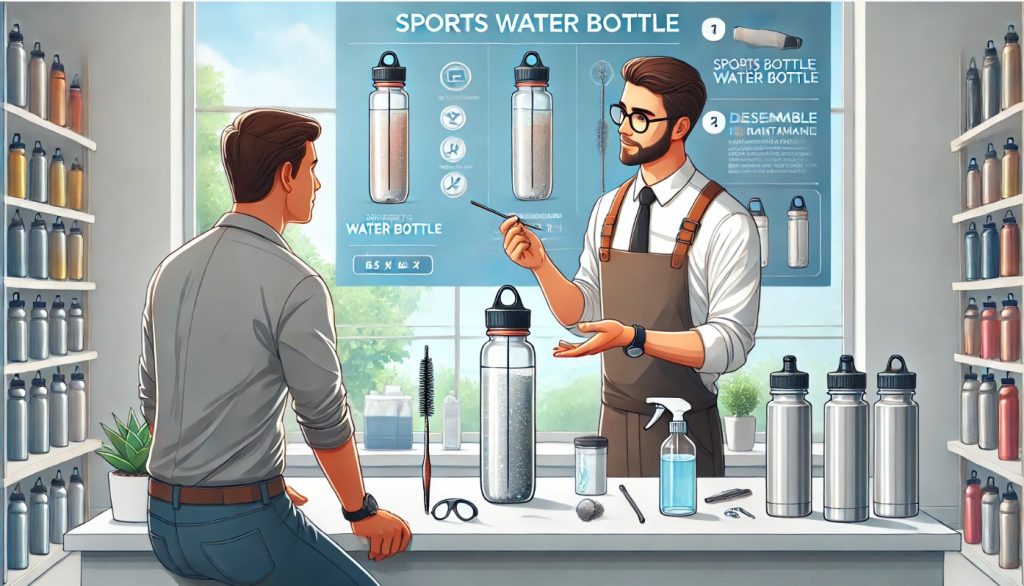Water bottles are essential items for staying hydrated and promoting a sustainable lifestyle. Whether made of stainless steel, glass, plastic, or other materials, they provide us with the convenience of having water readily available throughout the day. However, the longevity, hygiene, and performance of a water bottle heavily depend on how well it is maintained. Without proper care, a high-quality water bottle may lose its functionality, develop odors, or even get damaged, leaving customers dissatisfied.
For businesses, educating customers about proper care and maintenance not only helps them extend the life of their purchase but also ensures that they get the best possible user experience. Additionally, it reinforces the brand’s reputation for quality and customer service, and reduces product returns and complaints.
The Importance of Proper Care and Maintenance
Enhancing Longevity and Durability
Water bottles, like any other product, require regular care to perform optimally over time. Neglecting basic maintenance can lead to various issues like corrosion, staining, cracks, or diminished functionality. The longevity of a water bottle depends on several factors, including the material it is made of, the environment it’s used in, and how often it is cleaned. Proper maintenance ensures that the bottle continues to serve its purpose and gives the customer better value for their investment.
For example:
- Stainless Steel: While stainless steel is highly durable, regular cleaning and handling are required to avoid rusting or staining. A well-maintained stainless steel bottle will not only last longer but also retain its sleek appearance and keep beverages at the desired temperature.
- Glass: Glass water bottles are appreciated for their clean, neutral taste and eco-friendly qualities. With proper care, they can withstand years of use. However, glass is more fragile and prone to breakage if dropped or exposed to drastic temperature changes. Careful handling and cleaning are essential.
- Plastic: Plastic bottles are lightweight and affordable but often more prone to wear and tear. Over time, they may develop scratches, discoloration, or an unpleasant odor if not properly cared for. Regular cleaning and avoiding excessive exposure to heat can significantly prolong their life.
In short, educating customers on maintaining their water bottles can help reduce wear and tear, ultimately benefiting both the customer and the brand.
Health and Hygiene Considerations
Proper maintenance is also crucial for health and hygiene reasons. Water bottles are constantly exposed to moisture, which makes them susceptible to bacterial growth, mold, and mildew if not cleaned and dried properly. Bacteria can thrive in warm, moist environments, and if water bottles are not cleaned regularly, they can become a breeding ground for harmful germs.
By instructing customers on how to clean their bottles properly and often, brands can ensure that their customers enjoy safe, clean hydration. Additionally, regular care prevents the accumulation of unpleasant odors and prevents liquids from developing an off-taste.
A hygienic water bottle is crucial for promoting health. For example:
- Stainless Steel: These bottles are less likely to harbor bacteria due to their smooth surface. However, it’s important to clean both the interior and exterior regularly to ensure cleanliness.
- Glass: Glass water bottles do not absorb odors or stains, but without proper cleaning, mold can still form in small nooks and crannies.
- Plastic: Plastic water bottles are more prone to bacterial buildup, especially if they are not cleaned thoroughly after each use.
Maintaining Aesthetic Appeal and Functionality
Aside from functionality and hygiene, customers also care about the appearance of their water bottles. Over time, neglecting proper care can lead to issues like stains, discoloration, or surface scratches. For stainless steel bottles, this might mean watermarks or rust; for glass bottles, it could mean chips or cracks; and for plastic bottles, it could result in cloudiness or fading.
Functionality, too, can degrade without regular maintenance. The bottle’s cap and sealing mechanisms may wear out, making it prone to leaks, or the lid may become difficult to open or close properly. Regular care and proper storage can help maintain these crucial features and prevent them from failing prematurely.
For example:
- Stainless Steel: Scratches and dents can impact the insulation capabilities of the bottle. Even a minor crack in the exterior can cause the bottle’s insulation to fail, resulting in ineffective temperature control.
- Glass: Although glass is aesthetically pleasing, it is more prone to cracks and chips when not handled carefully. Also, glass bottles can become cloudy or stained over time if not cleaned regularly.
- Plastic: Plastic bottles are vulnerable to scratches, which not only affect their appearance but also create small nooks where bacteria can accumulate.
By offering clear instructions on maintaining these bottles, brands can ensure that customers enjoy their bottles in the best possible condition for years to come.
Material-Specific Maintenance Guidelines
Different materials require different care methods to maintain their appearance, functionality, and hygiene. Here, we’ll break down specific care guidelines based on the most common materials used for water bottles.
Stainless Steel Water Bottles
Stainless steel is a popular material for water bottles because of its strength, durability, and thermal properties. However, it requires regular maintenance to keep it looking its best and functioning properly.
Regular Cleaning
- Hand Washing: Although many stainless steel bottles are labeled as dishwasher-safe, hand washing is often the best option. Use a non-abrasive sponge and mild dish soap. Avoid harsh detergents or cleaning pads, as they can damage the surface and cause rust or stains.
- Use Warm Water: Always wash stainless steel bottles with warm water, as hot water may damage certain finishes or cause the bottle to deform.
- Dry Thoroughly: After cleaning, make sure the bottle is dried thoroughly to avoid water spots or rusting. Wipe it down with a soft cloth and leave it open to air dry if necessary.
Preventing Rust and Stains
- Vinegar or Baking Soda: To remove tough stains or lingering odors, fill the bottle with a mixture of white vinegar and water or baking soda. Let it sit for a few hours, then rinse thoroughly. This will remove stains and neutralize odors.
- Avoid Prolonged Exposure to Salt: Salt can cause pitting and corrosion on stainless steel over time. Always rinse your bottle after use with salty liquids, such as sports drinks or ocean water.
Proper Storage
- Store Upright: Always store the bottle upright to prevent leaks, and ensure that the lid is securely fastened.
- Avoid Extreme Temperatures: While stainless steel bottles are durable, they are sensitive to extreme temperature fluctuations. Avoid leaving the bottle in very hot or cold environments (e.g., a car in the summer or winter) for extended periods, as this can affect the insulation or cause warping.
Glass Water Bottles
Glass bottles are favored for their clean taste and eco-friendliness. They are chemically inert, meaning they won’t alter the flavor of your beverages. However, glass requires careful handling, as it is prone to breaking when dropped or exposed to sudden temperature changes.
Cleaning and Maintenance
- Hand Wash with Gentle Detergent: Clean your glass water bottle using warm water and mild dish soap. Avoid using harsh chemicals or abrasive sponges, as these can scratch the glass or damage any protective coatings.
- Dishwasher Safe: Many glass water bottles come with protective silicone sleeves, which can make them dishwasher safe. Always check the manufacturer’s instructions to confirm if your bottle is dishwasher-friendly.
- Use a Bottle Brush: A bottle brush is ideal for cleaning hard-to-reach areas at the bottom of the bottle. Make sure to clean thoroughly around the neck and lid to prevent mold or bacteria buildup.
Preventing Damage and Cracking
- Avoid Temperature Shock: Rapid temperature changes, such as moving from a hot environment to a cold one or pouring boiling water into a cold glass bottle, can cause glass to crack. Let your bottle adjust to room temperature before exposing it to extreme changes.
- Handle with Care: Glass is more fragile than other materials, so be cautious when handling your bottle. Use a protective sleeve to absorb shock from drops and protect the bottle from cracking.
Storing and Preventing Odors
- Store with Lid Off: After cleaning, store your glass bottle with the lid off to prevent moisture from being trapped inside, which could lead to mold or mildew.
- Dry Completely: Make sure the bottle is completely dry before closing the lid to prevent bacterial growth. Store in a dry, cool area.
Plastic Water Bottles
Plastic water bottles are affordable, lightweight, and often come in various designs and colors. However, plastic bottles are more susceptible to damage, discoloration, and odors over time, especially if not properly maintained.
Cleaning and Care
- Hand Wash Regularly: Use warm water and mild soap for cleaning. Avoid using harsh detergents, which can cause the plastic to degrade.
- Avoid the Dishwasher: While some plastic bottles are labeled as dishwasher-safe, it’s best to wash them by hand to avoid damage from high heat. The plastic can warp or degrade over time when exposed to high temperatures.
- Use a Soft Sponge: Avoid using abrasive sponges, as they can scratch the surface of the bottle, making it easier for bacteria to accumulate.
Preventing Odors and Staining
- Use Baking Soda or Vinegar: For tough odors or stains, fill the bottle with warm water and add a tablespoon of baking soda or vinegar. Let it sit for several hours, then rinse thoroughly. This will help neutralize odors and remove stains.
- Rinse After Use: Rinse the bottle immediately after use, especially if you’ve had sugary drinks, juices, or sports drinks, which can leave residues that are difficult to remove later.
- Store with Lid Off: Just like with glass bottles, storing plastic water bottles with the lid off helps them dry completely and prevents odors.
Educating Your Customers
For any business selling water bottles, educating your customers on proper maintenance practices is key. It can help ensure customer satisfaction, improve brand loyalty, and even boost repeat sales. Here are some ways to communicate these maintenance tips effectively:
Printed Instruction Guides
When customers purchase your water bottles, include a printed guide that outlines maintenance instructions specific to the bottle’s material and features. Clear, concise, and easy-to-follow guides will help customers feel confident in taking care of their new purchase. You can provide step-by-step visuals or diagrams to enhance understanding.
Online Resources
In addition to printed guides, consider creating online resources, such as instructional videos or blog posts, that offer detailed explanations on water bottle care. Customers can follow along visually with step-by-step instructions for cleaning, drying, and storing their bottles. Make these resources easily accessible on your website or via a QR code on the bottle packaging.
Customer Support
In addition to written or online instructions, make sure your customer support team is available to answer any questions customers might have about caring for their water bottles. Having a responsive and helpful customer support system will enhance your brand’s reputation and help customers feel more secure about their purchases.
By providing the right tools and guidance to your customers, you can ensure that they get the most out of their water bottles while reinforcing your brand’s commitment to quality and customer satisfaction.







